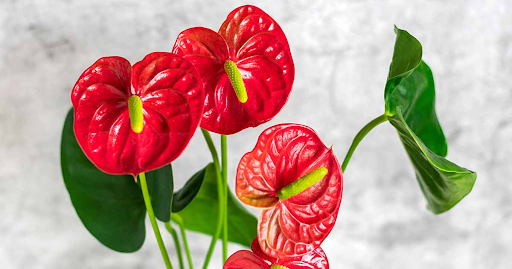Anthuriums, known for their striking, heart-shaped flowers and lush green foliage, are popular for indoor plant enthusiasts. These vibrant and easy-to-maintain plants can thrive in various conditions, making them an ideal choice for both beginners and experienced gardeners. This comprehensive guide will explore everything you need to know about growing anthurium plants as low-light indoor plants.
Anthuriums: A Brief Introduction
Anthuriums, commonly referred to as “laceleaf” or “flamingo flower,” are native to the tropical rainforests of Central and South America. They have gained popularity worldwide due to their unique, long-lasting, and exotic-looking flowers. These plants are not only appreciated for their vibrant blooms but also for their glossy, dark green leaves.
Why Choose Anthuriums as Low-Light Indoor Plants?
One of the primary reasons anthuriums are favoured as low-light indoor plants is their adaptability to various lighting conditions. Here’s why they make an excellent choice:
Tolerance to Low Light: Anthuriums are known for their ability to thrive in low to moderate light conditions. This makes them a perfect choice for homes or offices with limited access to natural sunlight.
Long-Lasting Blooms: Anthuriums produce their striking blooms even in low-light settings. These distinctive flowers can last for weeks or even months, adding a touch of elegance to your indoor space.
Air-Purifying Qualities: Anthuriums are aesthetically pleasing and contribute to improving indoor air quality by filtering out toxins.
Now that we understand why anthuriums are great for low-light environments let’s delve into how to care for them.
Anthurium Care Tips
Light Requirements:
Place your anthurium in a location with bright, indirect light. Avoid exposing it to direct sunlight, as this can scorch the leaves.
Low-light conditions, such as those found in north-facing windows or a few feet away from an east- or west-facing window, are ideal for anthuriums.
Watering:
Keep the soil consistently moist but not soggy. Water your anthurium when the top inch of the soil feels dry to the touch.
Water less during the winter months when the plant’s growth slows down.
Humidity:
Anthuriums thrive in high-humidity environments. If your indoor air is dry, consider using a humidity tray or room humidifier to maintain moisture levels.
Temperature:
Maintain a consistent temperature range of 65-80°F (18-27°C). Avoid exposing your anthurium to cold drafts or sudden temperature fluctuations.
Fertilisation:
Feed your anthurium with a balanced, liquid fertiliser every 6-8 weeks during the growing season (spring and summer).
Reduce or stop fertilising in the fall and winter when the plant’s growth slows down.
Pruning:
Prune dead or yellowing leaves to encourage new growth and maintain the plant’s appearance.
Common Anthurium Issues and Solutions
Yellow Leaves: Yellowing leaves can be a sign of overwatering. Allow the soil to dry slightly between waterings to prevent root rot.
Brown Leaf Tips: This can be caused by low humidity. Increase humidity levels or mist the plant regularly.
Pests: Keep an eye out for common indoor plant pests such as aphids and spider mites. Treat any infestations promptly with appropriate methods.
Conclusion
Anthuriums, often referred to as “low-light champions,” are the perfect addition to any indoor space, especially if you’re looking for an easy-to-care-for, low-light indoor plant that also boasts stunning, long-lasting blooms. By following the care tips outlined in this comprehensive guide, you can successfully grow and enjoy anthuriums as part of your indoor plant collection. Anthurium plants not only enhance the aesthetics of your home but also contribute to cleaner, fresher air, making them a valuable addition to your indoor garden. So, whether you’re a novice or a seasoned indoor gardener, anthuriums are an excellent choice to brighten up your low-light spaces.





